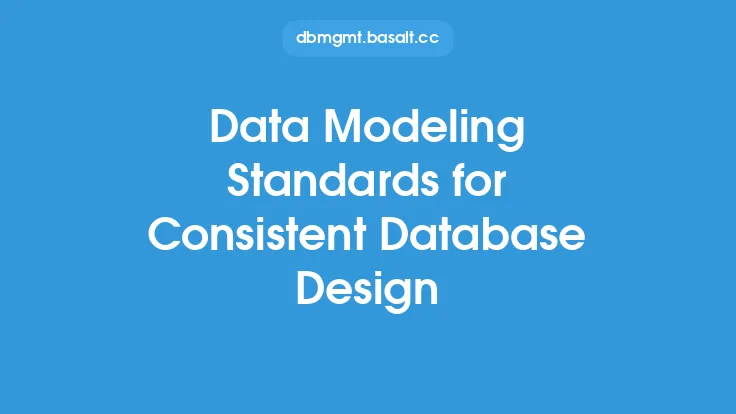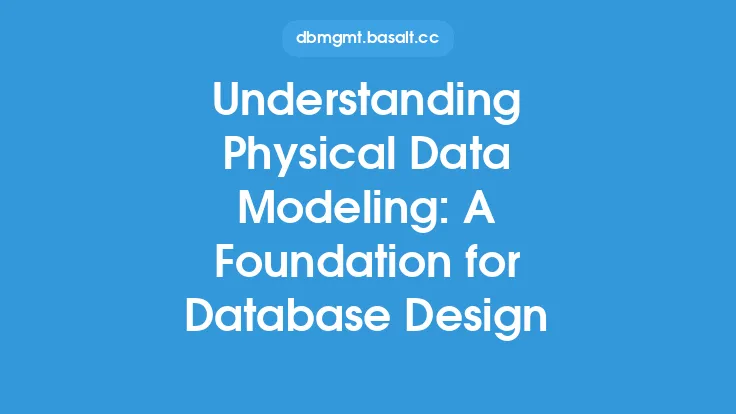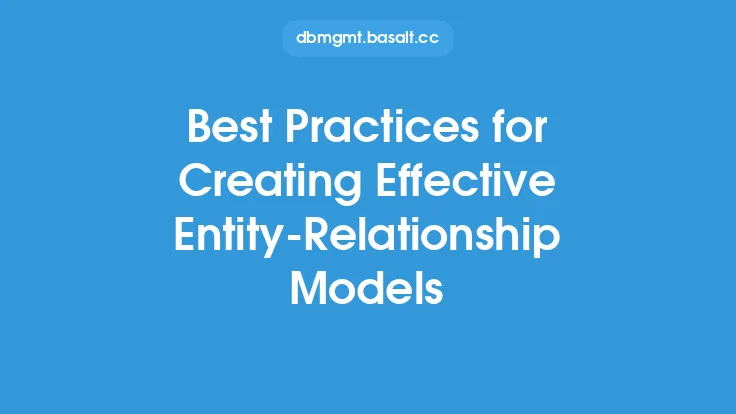Entity-Relationship modeling is a fundamental concept in database design that helps to create a conceptual representation of the data and its relationships. To effectively design and implement a database, it is essential to have the right tools and techniques. In this article, we will explore the various entity-relationship modeling tools and techniques that can be used for database design.
Introduction to Entity-Relationship Modeling Tools
Entity-Relationship modeling tools are software applications that help to create, design, and manage entity-relationship models. These tools provide a graphical interface to create entity-relationship diagrams, which are visual representations of the entities, attributes, and relationships in a database. Some popular entity-relationship modeling tools include ERwin, Entity Framework, and DbDesigner. These tools offer a range of features, such as drag-and-drop interfaces, automatic generation of SQL code, and support for various database management systems.
Techniques for Entity-Relationship Modeling
There are several techniques that can be used for entity-relationship modeling, including the use of entity-relationship diagrams, object-role modeling, and dimensional modeling. Entity-relationship diagrams are a visual representation of the entities, attributes, and relationships in a database. Object-role modeling is a technique that focuses on the roles that entities play in a database, while dimensional modeling is a technique that is used to design data warehouses. Each of these techniques has its own strengths and weaknesses, and the choice of technique will depend on the specific requirements of the database.
Data Modeling Techniques
Data modeling is a critical component of entity-relationship modeling, and there are several data modeling techniques that can be used. These include the use of entity-relationship diagrams, data flow diagrams, and object-oriented modeling. Entity-relationship diagrams are a visual representation of the entities, attributes, and relationships in a database, while data flow diagrams show the flow of data between entities. Object-oriented modeling is a technique that uses objects to represent entities and their relationships. Each of these techniques has its own strengths and weaknesses, and the choice of technique will depend on the specific requirements of the database.
Database Design Tools
Database design tools are software applications that help to design and implement databases. These tools provide a range of features, such as data modeling, SQL generation, and database administration. Some popular database design tools include MySQL Workbench, Oracle Enterprise Manager, and Microsoft SQL Server Management Studio. These tools offer a range of features, such as drag-and-drop interfaces, automatic generation of SQL code, and support for various database management systems.
Entity-Relationship Modeling Notations
Entity-relationship modeling notations are used to represent entities, attributes, and relationships in a database. There are several notations that can be used, including Chen's notation, Crow's Foot notation, and Bachman's notation. Chen's notation is a popular notation that uses rectangles to represent entities and lines to represent relationships. Crow's Foot notation is a variation of Chen's notation that uses a crow's foot symbol to represent relationships. Bachman's notation is a notation that uses boxes to represent entities and lines to represent relationships. Each of these notations has its own strengths and weaknesses, and the choice of notation will depend on the specific requirements of the database.
Best Practices for Using Entity-Relationship Modeling Tools
There are several best practices that can be used when working with entity-relationship modeling tools. These include the use of a consistent notation, the creation of a data dictionary, and the use of automatic generation of SQL code. A consistent notation is essential to ensure that the entity-relationship model is easy to understand and maintain. A data dictionary is a document that describes the entities, attributes, and relationships in a database, and is essential for ensuring data consistency and integrity. Automatic generation of SQL code can save time and reduce errors, and is a feature that is offered by many entity-relationship modeling tools.
Common Challenges in Entity-Relationship Modeling
There are several common challenges that can occur when working with entity-relationship modeling tools. These include the complexity of the entity-relationship model, the need for data consistency and integrity, and the requirement for scalability and performance. The complexity of the entity-relationship model can make it difficult to understand and maintain, and can require specialized skills and knowledge. The need for data consistency and integrity is essential to ensure that the data is accurate and reliable, and can require the use of data validation and data normalization techniques. The requirement for scalability and performance is essential to ensure that the database can handle large volumes of data and user traffic, and can require the use of distributed databases and parallel processing techniques.
Future of Entity-Relationship Modeling
The future of entity-relationship modeling is likely to be shaped by advances in technology and changes in the way that data is used and managed. Some of the trends that are likely to shape the future of entity-relationship modeling include the use of cloud-based databases, the adoption of big data technologies, and the increasing use of artificial intelligence and machine learning. Cloud-based databases offer a range of benefits, including scalability, flexibility, and cost savings, and are likely to become increasingly popular in the future. Big data technologies, such as Hadoop and NoSQL databases, offer a range of benefits, including the ability to handle large volumes of data and the ability to perform complex analytics. Artificial intelligence and machine learning are likely to play an increasingly important role in entity-relationship modeling, and can be used to automate tasks, improve data quality, and provide insights into data usage and management.
Conclusion
Entity-relationship modeling is a fundamental concept in database design that helps to create a conceptual representation of the data and its relationships. To effectively design and implement a database, it is essential to have the right tools and techniques. In this article, we have explored the various entity-relationship modeling tools and techniques that can be used for database design, including entity-relationship modeling tools, data modeling techniques, database design tools, entity-relationship modeling notations, and best practices for using entity-relationship modeling tools. We have also discussed some of the common challenges that can occur when working with entity-relationship modeling tools, and have looked at the future of entity-relationship modeling. By using the right tools and techniques, and by following best practices, it is possible to create effective entity-relationship models that meet the needs of the organization and support the management of data.





